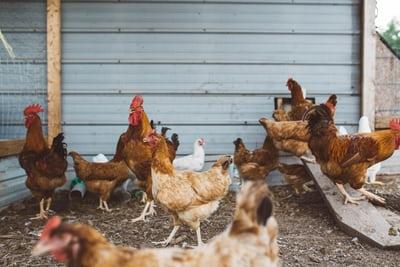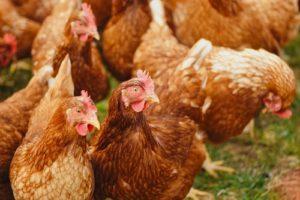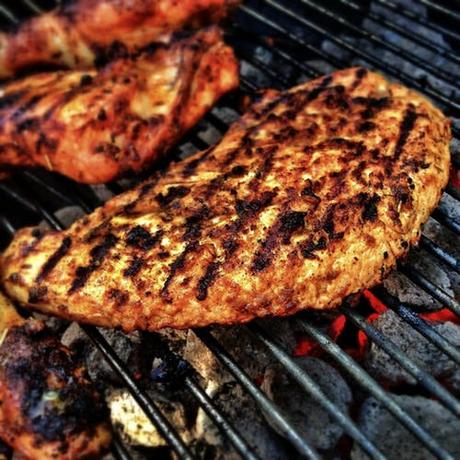
In Southeast Asia, half of the poultry production takes place on intensive medium to large scale commercial farms. The other half are raised in back yards of small farmers who keep a few dozen chickens, geese, ducks or turkeys. This will be a source of income for small farmers.
The Asian market for chicken meat and eggs is undergoing significant growth, driven by rising incomes, and changing demographics and tastes. Southeast Asia's poultry production expanded by 56% in the last decade, growing from 5.9 million metric tons (mmt) to 9.2 mmt in 2018. It is expected to reach 12.3 mmt by 2028.
Poultry Production in the Philippines
Poultry production in the Philippines is classified into "commercial" and "backyard" production. A poultry farm is classed as "commercial" if it has more than 100 birds. Backyard produced chickens face more risk of disease as there is little to no bio security in place.

Commercial production is when the chickens are produced and bred on a farm in large quantities, with better technology to control temperatures. Commercial production is for major food suppliers, such as supermarkets, which account for 65% of the total broiler supply in the country.

As of 1st January 2019, the total chicken inventory was estimated at 186.37 million birds. It went up by 6.03 percent compared with the previous year's record of 175.77 million birds. The increase in demand for poultry meat is due to an increase in population with a demand for better quality products.
In the Philippines, there has been an increase in street food kiosk chains, with the majority selling chicken products. As it is a cheap, fast way to get food, it is making poultry more accessible daily.
Poultry Production in Indonesia

Indonesia is the largest country in Southeast Asia. It has a fast growing, relatively young population of almost 250 million. As poultry products are one of the most affordable sources of protein, the demand for high quality products increases. this is because the population are increasingly becoming more urbanised with a desire for a healthy lifestyle.
The majority of Indonesia's birds are farmed in small open houses, housing 3,000-20,000 birds. These types of farms see a higher number of fallen stock, compared to commercial farms, as a result of disease and high temperatures.
Chicken meat demand in Indonesia this year is projected to increase by 6.2% to 3.25mt. to keep up with the demands, investments in technologies and production capacity must be made.
Production Of Poultry in Cambodia

In Cambodia, it is estimated that almost every single household (except majority of urban households) are involved in poultry production. this amounts to 94% in non-commercial farms and just 6% being raised on commercial farms.
There is an estimated 108 commercial chicken broiler farms currently in Cambodia. However, this number is on the rise and will continue to increase. This is a result of the awareness of quality products and health and hygiene when it comes to poultry farming.
The Production of Poultry in Malaysia

In 2018, the poultry consumption per capita in Malaysia was approximately 46.7 kilograms. It is expected to amount to around 47.95 kilograms per person annually.
Adopting modern technologies in production, such as automated feeding systems and temperature controlled broiler houses, has allowed poultry production in Malaysia to continuously increase.
What is Poultry Waste and Why Should You Get Rid of It?
With the increase in poultry products throughout Southeast Asia, the waste produced from the farms will be significantly high. It is important that you dispose of poultry waste quickly and efficiently.
Tackling the problem of waste will help to reduce the risk of disease and infection amongst the poultry. This would help to avoid the slowing down of production as all of your stock will be healthy and of high standard. If your stock is healthy, this would improve product quality and your reputation as a business.
Types of waste you will find on a poultry farm include:

- Dead birds (fallen stock)
- Poultry Manure
- Dressing waste
- Poultry litter
Incineration is the best method of disposal for controlling bio-security. Incineration can help you control and prevent diseases from infecting your stock. Our bird flu incinerators can help to control diseases such as:
- Avian Bird Flu (Avian Influenza)
- Newcastle Disease
- A(H1N1) and A(H3N2) strains
- LPAI & PAI strains
Inciner8 offer a wide range of poultry incinerators to help you dispose of your poultry waste.

The i8-55A
The i8-55A is a medium capacity animal incinerator from our range of 'DEFRA Approved' models. It is especially suitable for disposing of birds and poultry waste. This option benefits from a simple top loading door and advanced secondary chamber technology. This provides an environmentally friendly option for a variety of industries.

The i8-75A
The I8-75A model is a mid-range incinerator, giving you quality design and engineering. The i8-75A is a medium capacity animal incinerator from our range of 'DEFRA Approved' models. This model is suitable for disposing of game, deer, poultry, sheep waste.
The i8-140A

The i8-140A is a high capacity animal incinerator which is suitable for disposing of large domestic animals, sheep, lambs and many others. This model is an ideal waste disposal solution for farms, shooting practices, slaughterhouses, abattoirs or veterinary practices.

